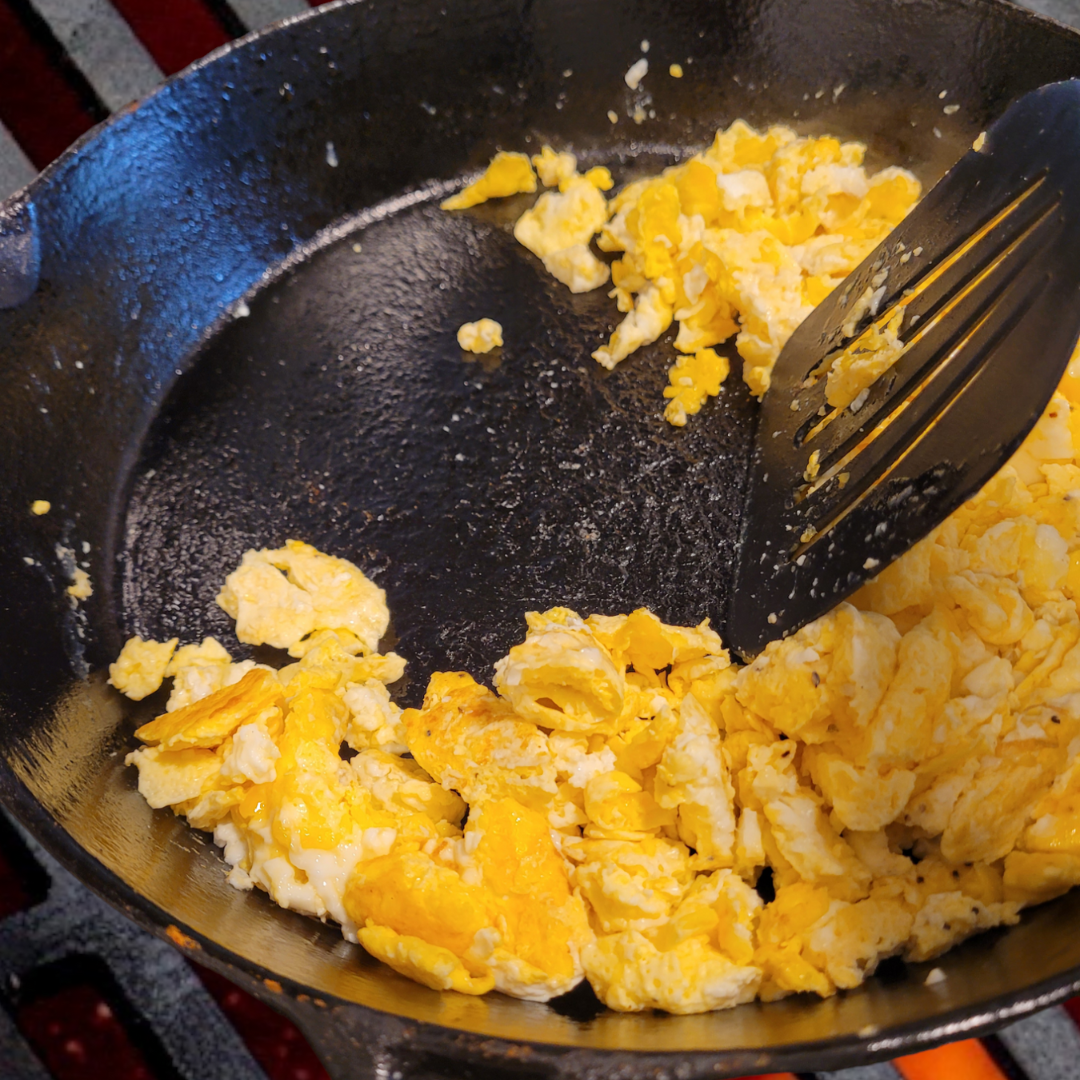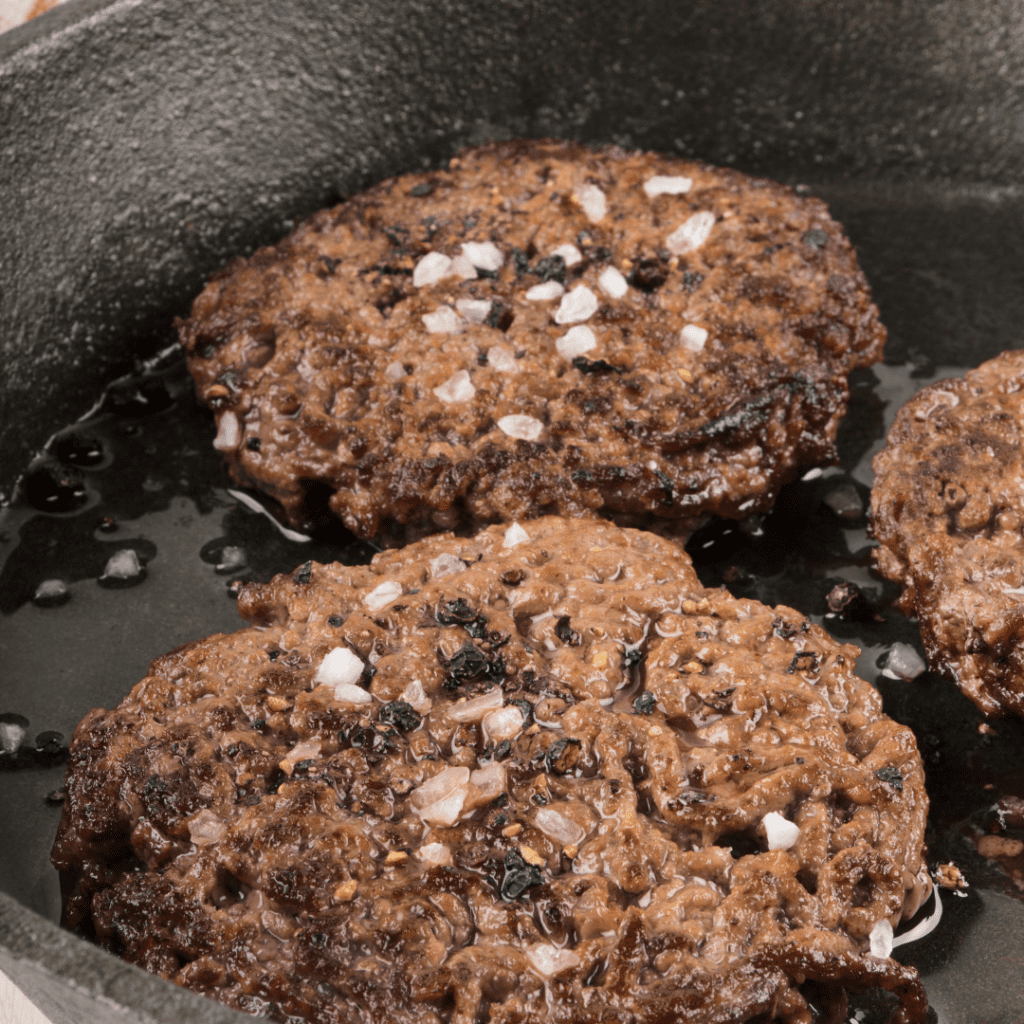Scrambled eggs in a cast iron skillet.
Cooking the perfect scrambled eggs can often feel like an elusive culinary achievement, especially when using a cast iron skillet. These skillets are beloved for their heat retention and versatility, but they can be notorious for making eggs stick.
A sticky situation can turn your dream of fluffy, soft scrambled eggs into a cleaning nightmare! Ask me how I know! But with a few simple tricks up your sleeve, you can master the art of cooking non-sticky scrambled eggs in your cast iron skillet! Let’s discover the secrets that will transform your breakfast game!
This is a pinnable post. Tap or hover over any image in this post to pin to your Pinterest Boards.
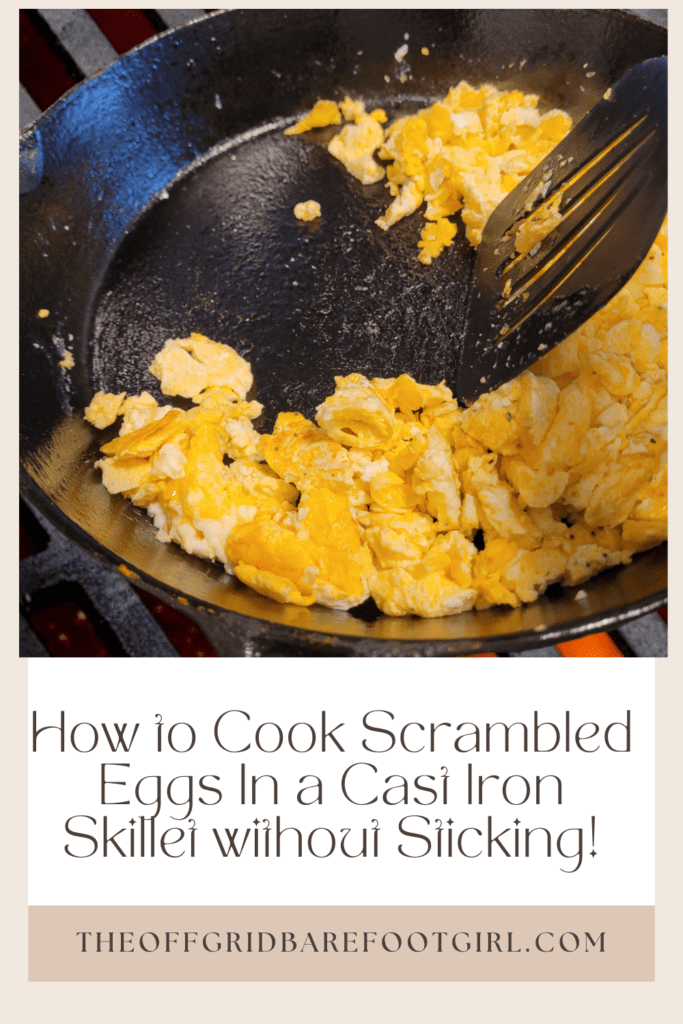
Benefits of Using a Cast Iron Skillet
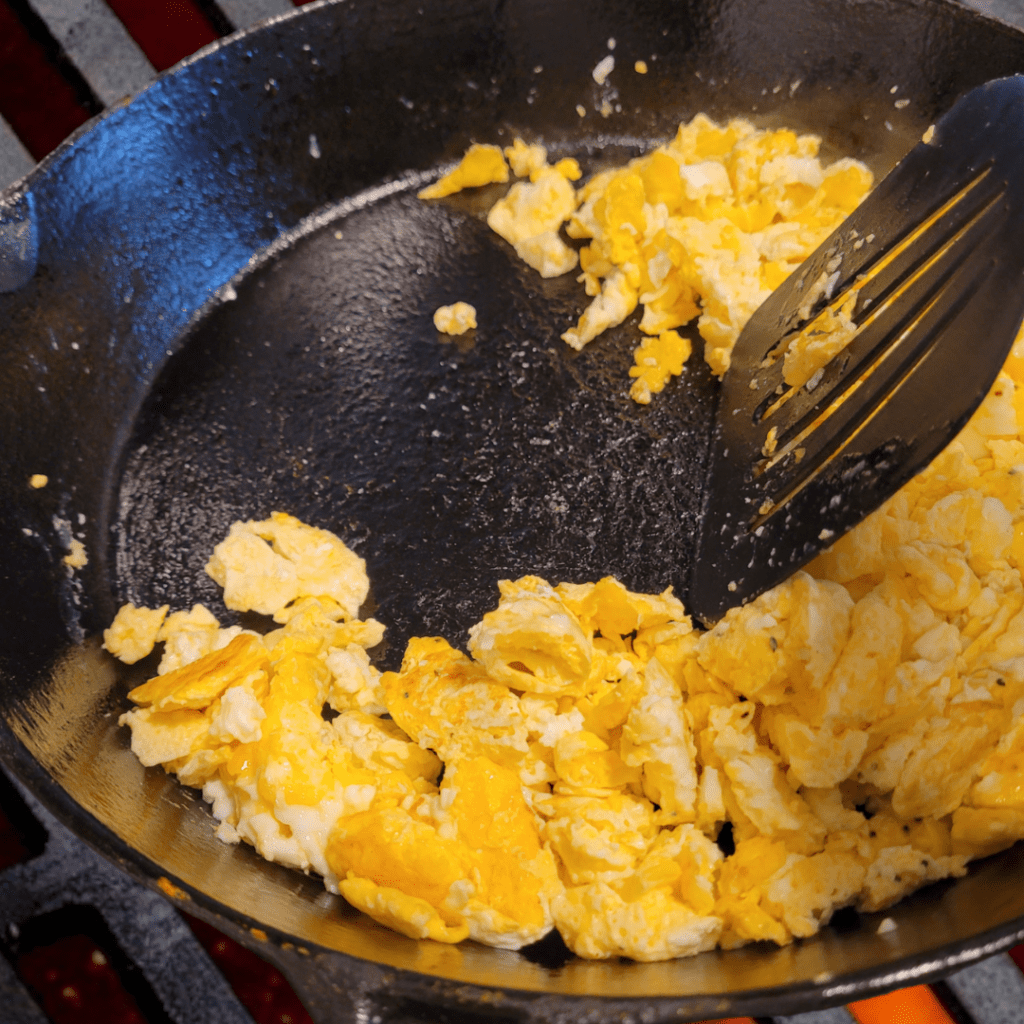
Why Cooking Scrambled Eggs In a Cast Iron Skillet Is Beneficial
There’s something almost magical about cooking with a cast iron skillet. Its hefty presence on the stove speaks of tradition and durability. Not only do these time-tested pans excel in heat retention, but they also evenly distribute heat, making them perfect for a variety of dishes beyond just scrambled eggs. From searing steaks to baking cornbread, a cast iron skillet handles it all with ease.
Also, with each use, a cast iron skillet becomes more seasoned, gradually building up a natural, non-stick coating. This patina is a game-changer for cooking, allowing food to release more easily over time. Perhaps the most compelling aspect, though, is its contribution to our health by adding a small amount of iron to our diet, something I have battled with most of my life with iron deficiency anemia. It’s a kitchen workhorse that combines functionality with a whisper of nutritional benefit, making it a beloved tool in kitchens everywhere.
Seasoning Your Cast Iron Skillet
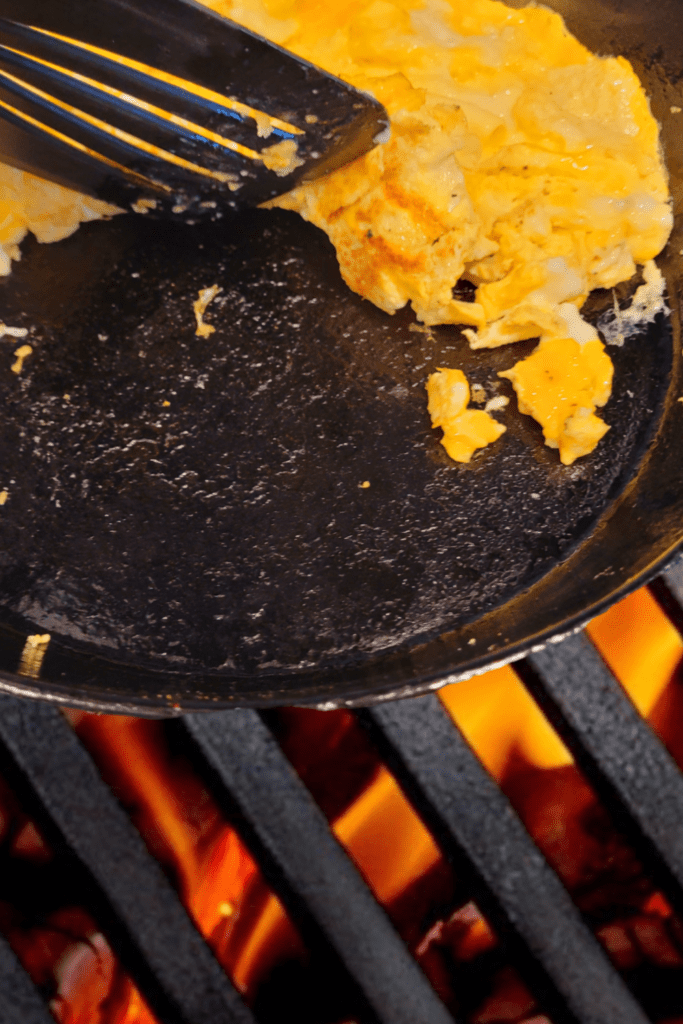
How to Season Your Pan for Cooking Scrambled Eggs In a Cast Iron Skillet
This isn’t just a fancy term chefs throw around—it’s the secret sauce for a non-stick cast iron skillet. Seasoning forms a protective layer that not only prevents sticking, but adds a bit of flavor to everything you cook.
So, how do you get it right? It’s simpler than you might think. Start with a clean skillet. Wipe it down, then coat it lightly with a high-smoke point oil. I’m talking canola, vegetable, or even flaxseed. Then, heat it upside down in a 350°F oven for an hour. Let it cool in the oven, and voilà—a beautifully seasoned skillet!
Remember, seasoning isn’t a one-and-done deal. After every use, give your skillet a little love. A quick rinse, a light oiling, and gentle heat on the stove will keep that non-stick surface in top shape. Think of it as feeding your skillet a small snack to keep its powers strong. With proper seasoning, your scrambled eggs will slide right off, with no sticking or fuss.
Read my helpful post on how I season my cast iron pans to continue using them without much of a fuss.
How to Season Cast Iron for Cooking
Preheating the Skillet
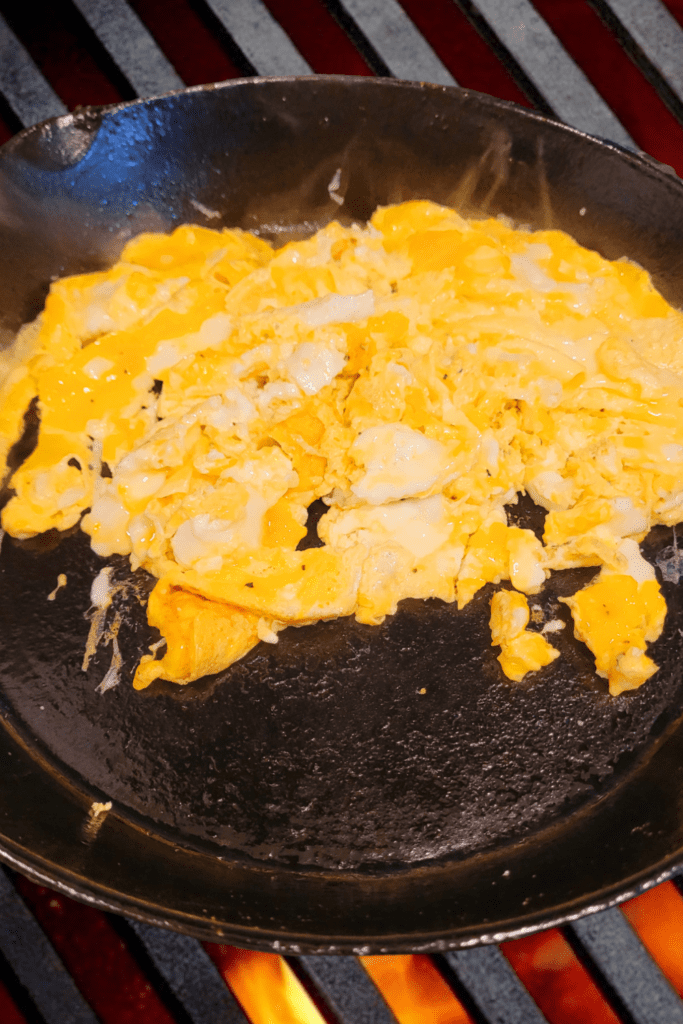
This step is crucial and often overlooked, but it sets the stage for a non-stick breakfast masterpiece.
Starting with a cold skillet can lead to uneven cooking and, unfortunately, eggs sticking like glue. To avoid this culinary faux pas, place your skillet on the stove over medium heat for about 10 minutes before you introduce any eggs. You’re looking for that sweet spot where the pan is evenly heated, a condition that’s perfect for cooking.
How do you know it’s ready? Sprinkle a few drops of water onto the skillet. If they dance around before evaporating, your cast iron stage is set, and it’s showtime for your eggs.
Using the Right Amount of Fat for Cast Iron Cooking
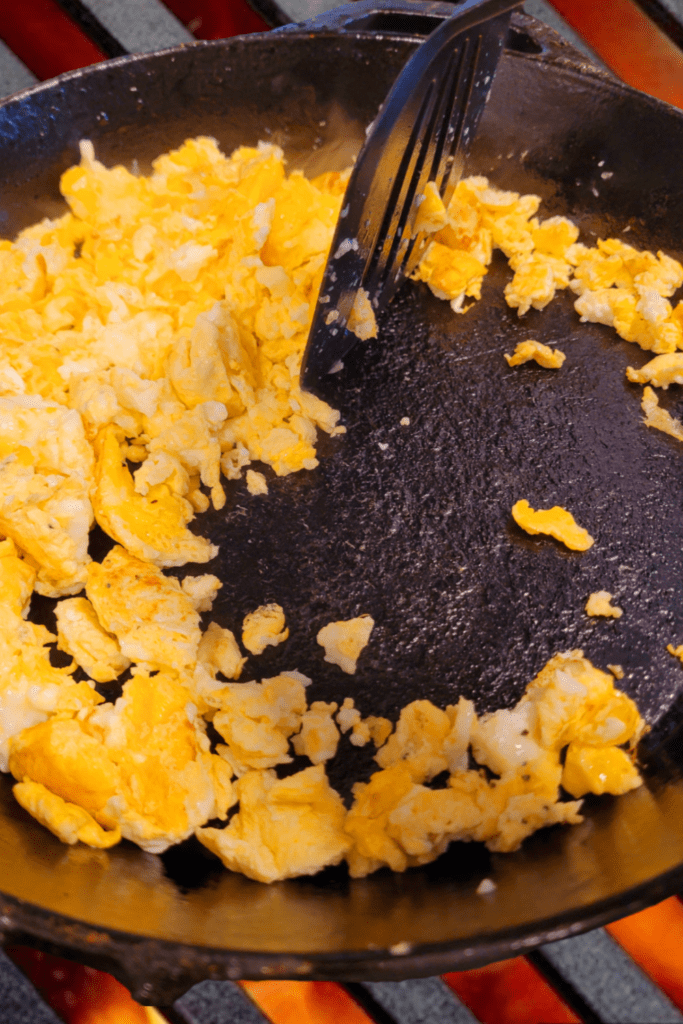
When it comes to preventing scrambled eggs from sticking to a cast iron skillet, the magic trick is using the right amount of fat. Whether you’re a fan of butter for its flavor or prefer oils with a higher smoke point, like canola or avocado, a generous swipe across the skillet’s surface is key.
You’re not deep frying, but you definitely don’t want to skimp on this step. Aim for a light, even coating that covers the entire surface; this not only prevents your eggs from sticking, but also contributes to that golden, delicious exterior we all love. Remember, the fat not only cooks; it acts as a barrier between the skillet and the eggs, ensuring a frustration-free and tasty breakfast experience!
Avoiding High Heat, What?
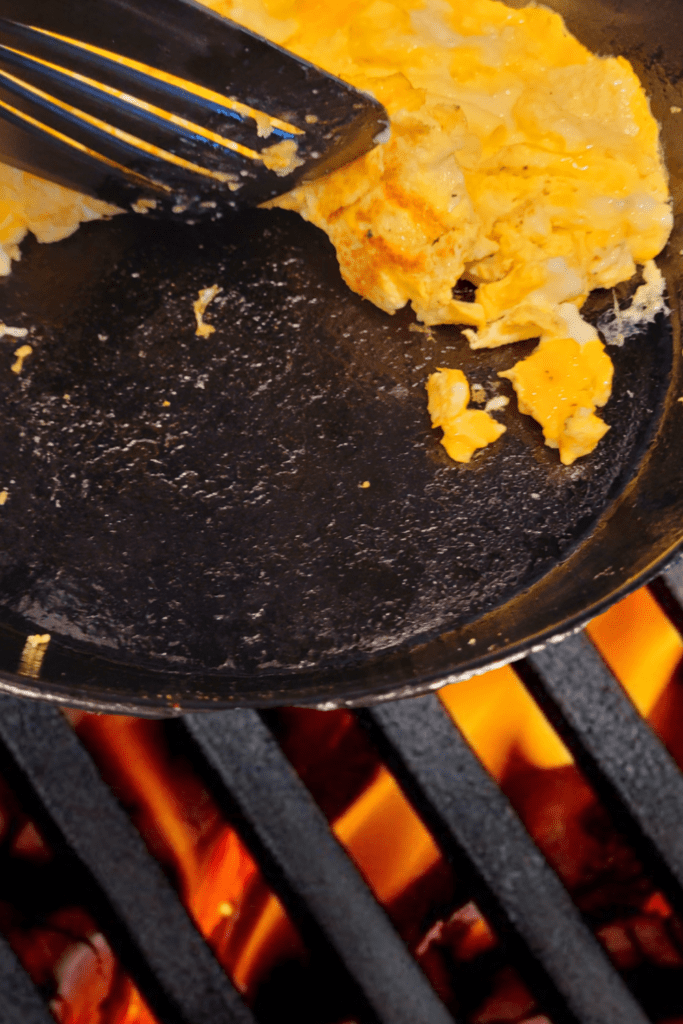
Many think that since you are using cast iron for cooking, you can crank up that heat! But, let’s talk about that heat for a minute — a critical factor many overlook. Think of your cast iron skillet as a slow-and-steady type. It’s not about rushing. Cranking up the heat thinking it’ll cook your scrambled eggs faster? That’s a recipe for them sticking to the pan. High heat can cause the eggs to grip onto the skillet like they’re clinging for dear life. Plus, it can overcook them, making your scrambled eggs less fluffy and more like a rubbery mess.
The trick is to keep the flame low to medium. This gentle approach heats the skillet evenly, allowing the eggs to cook slowly, staying tender and non-stick. Patience is key here. Give your eggs the time to warm up to the idea of cooking, ushering them gently to perfection. It sounds a bit like nurturing, doesn’t it? Well, that’s exactly what it is.
Constant Movement and Gentle Heat
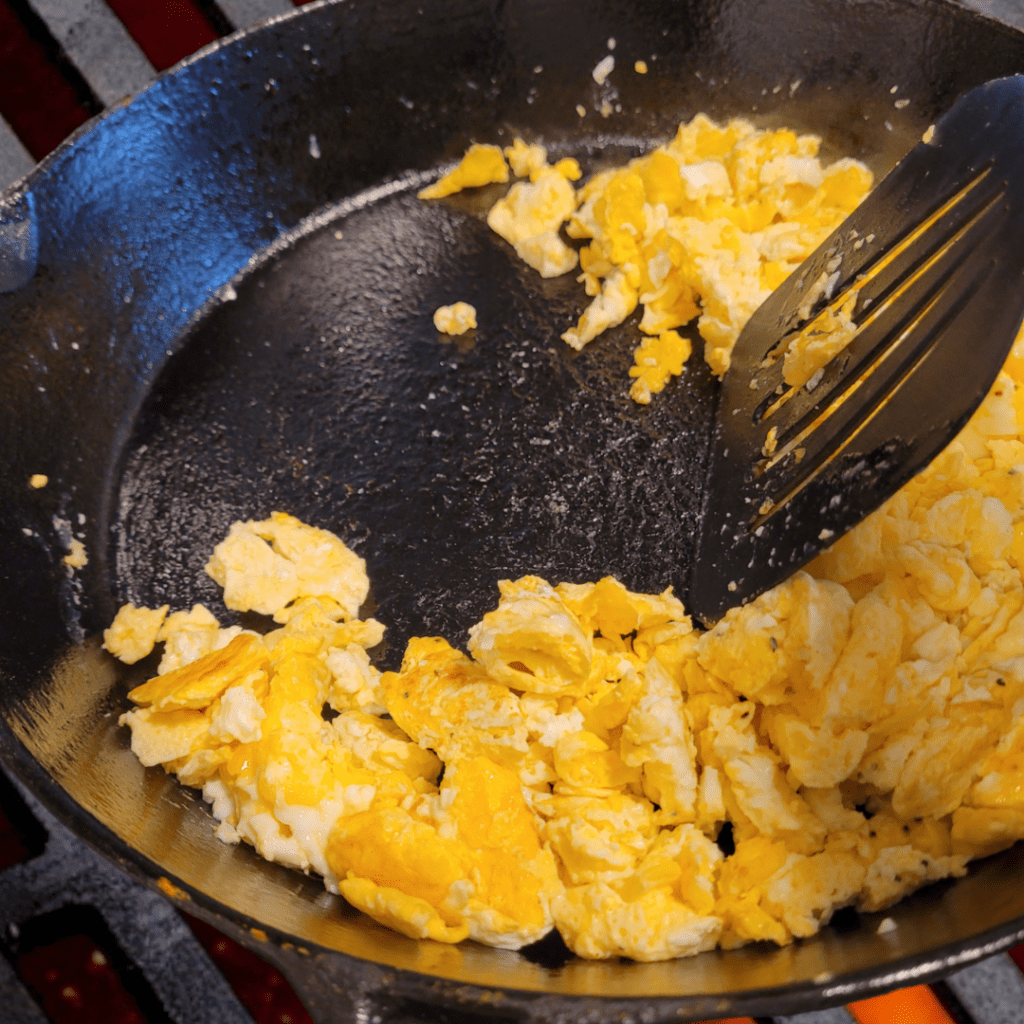
Here’s the thing about scrambled eggs in a cast iron skillet: they crave attention. Imagine you’re gently coaxing the eggs to cook just right. Starting on low to medium heat is key because high heat is like an open invitation for the eggs to stick and, ultimately, ruin your morning vibe.
Whisk the amount of eggs you want to scramble in a bowl with one teaspoon of whole milk or water per egg. Adding liquid like milk or water to your scrambled egg mixture helps make it light and fluffy. Now is also a good time to add in any spices you will be using.
Pour the egg mixture onto the skillet. Allow it to sit for a moment to firm up, but not let the eggs sit for too long on one spot in the skillet. Use a spatula to stir and fold the eggs gently. This method distributes the heat evenly, ensuring every bit of your eggs cooks to perfection without clinging desperately to the bottom of the pan.
Cleaning and Maintenance
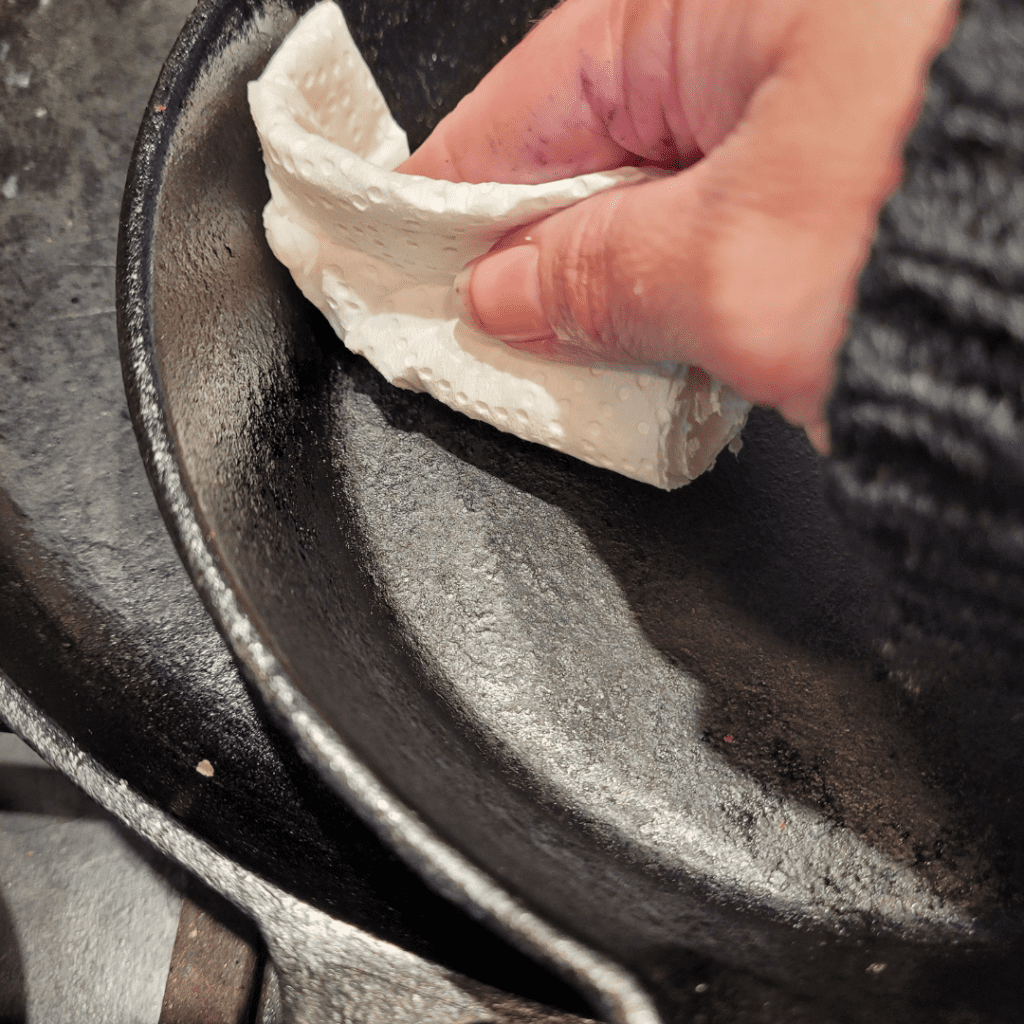
After cooking those perfect eggs, cleaning your cast iron skillet is crucial. Cool it down, then use hot water and a non-abrasive scrubber to clean. Dry it thoroughly to prevent rust. For an extra touch, lightly coat it with oil before storing it.
This routine not only keeps your skillet stick-resistant, but also enhances its longevity. Remember, proper care makes your next cooking adventure smooth and enjoyable!
Conclusion
In wrapping up, keeping scrambled eggs from sticking to your cast iron skillet boils down to a few key steps: properly seasoning your skillet, preheating it, using enough fat, avoiding high heat, and incorporating gentle movements. Remember these golden rules, and you’ll not only preserve the quality of your skillet, but also enjoy perfect scrambled eggs every time. It’s about treating your skillet right, and in return, it will make your cooking experiences smoother and more enjoyable. Keep practicing, and soon, you’ll master the art of cooking with cast iron!
Resources: Here are some helpful resources for further information.
- How to Make Non-Stick Eggs In a Cast Iron Skillet – By The Praire Homestead (I love her blog!)
- How to Make Scrambled Eggs In a Cast Iron – By Lodge Cast Iron
- The Best Way to Prevent Eggs From Sticking to a Cast Iron Skillet – By Tasting Table
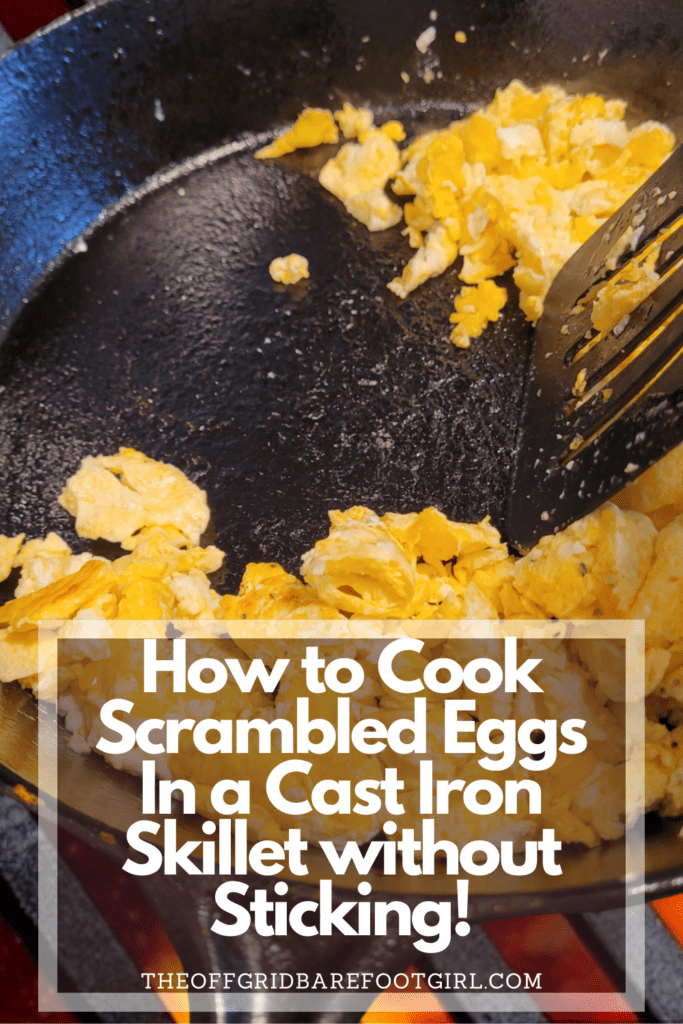
Frequently Asked Questions
1. What temperature should the skillet be set to when cooking scrambled eggs?
When cooking scrambled eggs, it’s essential to start with a skillet set over medium-low heat. This temperature allows for the eggs to cook slowly and evenly, preventing them from becoming tough or rubbery. You’ll want to avoid high temperatures as they can cause the eggs to cook too quickly and result in a dry, overcooked texture. By keeping the skillet at moderate heat, you give yourself time to gently stir the eggs as they cook, creating light and fluffy curds. Remember, patience is key when making scrambled eggs – let them take their time on the stove for a delicious end result every time!
2. What type of cast iron skillet is best for cooking scrambled eggs?
When it comes to cooking scrambled eggs in a cast iron skillet, you want to look for a pan that is well-seasoned and has a smooth surface. A traditional cast iron skillet works best for this task, as it retains heat evenly and provides a non-stick surface when properly seasoned. Choose a pan with sloped sides to easily manipulate the eggs while they cook. Avoid using enameled or coated cast iron skillets for scrambled eggs, as these surfaces may not provide the same level of non-stick properties as traditional seasoned cast iron. Overall, the best type of cast iron skillet for cooking perfect scrambled eggs is one that is well-maintained, seasoned, and ready to go at a moment’s notice for your breakfast cravings.
3. Should the eggs be whisked before adding them to the skillet?
It’s a hotly debated topic in the world of breakfast cooking – should you whisk your eggs before adding them to the skillet for scrambled eggs? Some people swear by whisking, claiming it leads to fluffier and more evenly cooked eggs. Others argue that whisking can introduce too much air into the mixture, resulting in a less creamy texture. Ultimately, whether or not you should whisk your eggs comes down to personal preference. Whisking can help incorporate the whites and yolks more thoroughly, but stirring with a fork may achieve similar results without introducing as much air. Experiment with both methods and see which one produces the scrambled eggs of your dreams!
4. How much butter or oil should be used to prevent sticking?
When it comes to making scrambled eggs, the amount of butter or oil you use can greatly impact the final result. The general rule of thumb is to use about 1 tablespoon of butter or oil for every 3-4 eggs. This should be enough to prevent sticking and ensure that your eggs cook evenly. However, if you prefer a richer flavor and creamier texture, you can always add a bit more butter or oil. Just be sure not to overdo it, as too much fat can make your eggs greasy and unappetizing. Overall, finding the right balance of butter or oil is key to achieving perfectly cooked scrambled eggs that are both fluffy and flavorful.
Summary
I hope I have inspired you to cook scrambled eggs in your cast iron skillet to enjoy and share with your friends and family.
If you were encouraged by this post, I invite you to check out my FREE Printables Page for fun free printables, planners, and charts.
ENTER MY FREE Printables Page HERE
Here are some more of my cast iron cooking inspiration posts to check out!
How to Season Cast Iron for Cooking
The Best Old-Fashioned Homemade Brownies: A Cast Iron Skillet Recipe!
How to Make Dutch Oven Lasagna
How to Make Black Bean Burgers from the Garden!
Blessings,
The Off Grid Barefoot Girl

